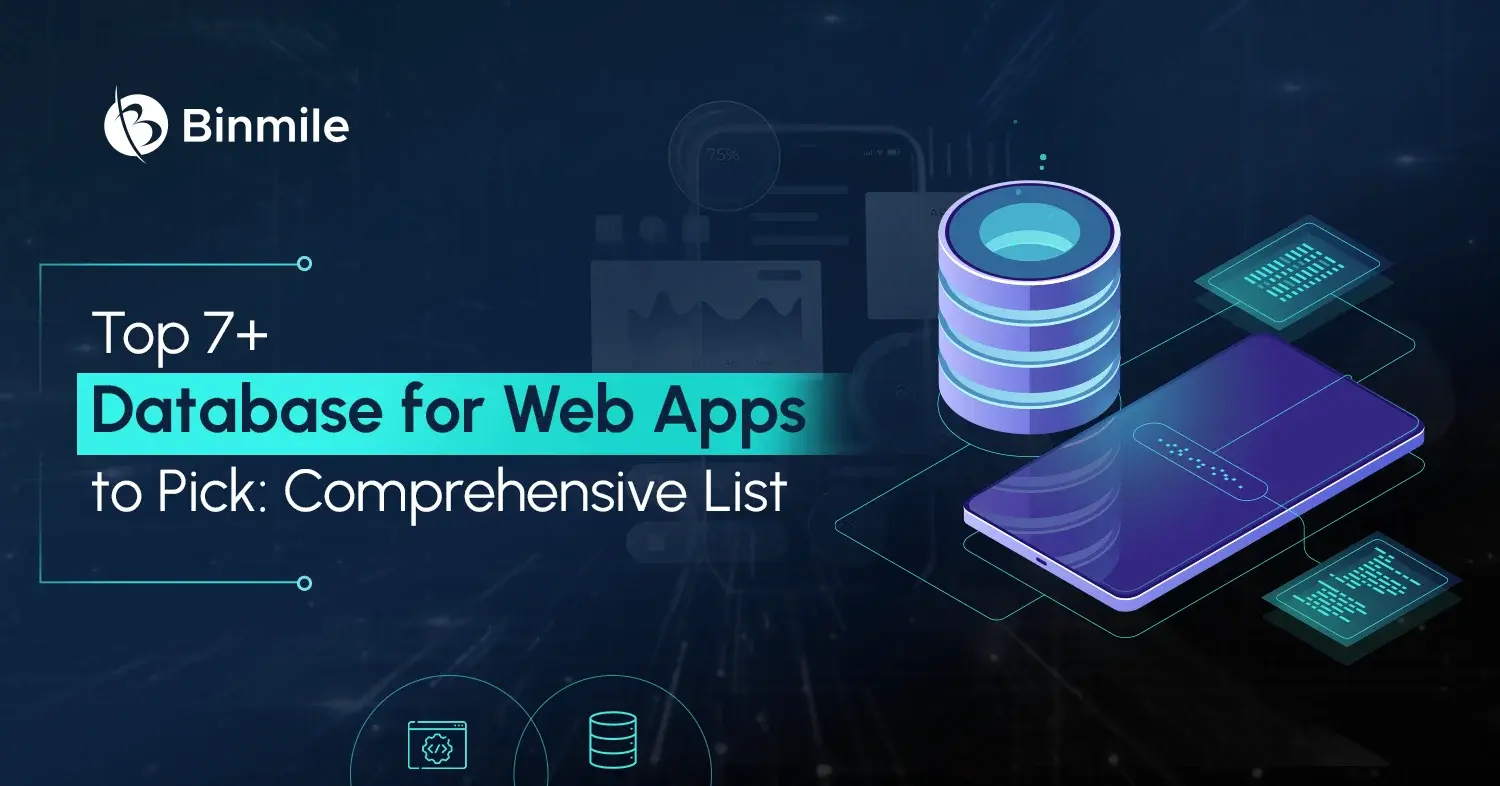- 10 Best Databases for Web Applications to Use in 2024
- best databases for web apps
- Choose The Right Database for Your Application
- Choosing the Ideal Database
- Choosing the Right Database for Your Web Application
- how to choose database for web apps
- Top 10 Databases for Web Apps
- Top 5 Tips for Choosing the Right Database for Your Project
- top benefits of the database for web apps
- top database for web apps
- web database
- Which database is best for web applications?
Data is fuel in this digital economy and its significance in mobile app development services and web application development is understated. A database is a digital warehouse where all your website’s information is stored. The information could include user data, product details, customer orders, etc. Databases for web apps do more than just allow for data exchange between the web application and the database management. It also enhances security mechanisms, protects stored data, confirms user identity, and regulates data access. Essentially, it’s the backbone of your web application, holding everything together and ensuring that your website functions smoothly.
Therefore, databases are crucial to web development, as they store and manage data critical to a website’s operation. So, whether you’re building a simple blog or going for a complex e-commerce website development, effective database management is the key to optimal performance and scalability. Thus, choosing the right database for your web application becomes a critical technology decision to make. But with markets filled with options, which one is the best? What to do? or how to select the database management system that works for you? If you’re also grappling with these questions, we’ve got you covered. We’ve scouted the internet and also spoken to our database engineers to come up with a list of the best databases for web apps.
Ready? Let’s dive in!
Database for Web Apps: Introduction, Benefits & List
As discussed earlier, web database offer a central location for keeping information. This data could include details of top web app development companies, user transactions, or other data that powers your web applications. There’s more to it. So let’s understand the top benefits of the web database:
- It can handle growing data volumes and user traffic efficiently, ensuring your web app remains smooth and responsive as it scales.
- Databases organize information logically, making it easy to find and manage. Built-in security features such as web app authentication protect sensitive data from unauthorized access.
- It also ensures data consistency and accuracy. Backups and recovery mechanisms minimize downtime and data loss risks.
- Teams can work together efficiently on a centralized data source. Access controls manage user permissions for secure data sharing.
- It enables you to extract insights through queries and reporting tools, helping you make data-driven decisions for your web app’s future.
Top 10 Databases for Web Application Development
Here’s a list of popular databases for web apps, along with their key features:

1. MySQL
It’s an open-source relational database (RDBMS) known for affordability, ease of use, and flexibility. A popular choice for small to medium-sized applications, often used in the LAMP stack.
Top Features:
- Open-source and cost-effective.
- User-friendly interface with a large support community.
- Scalable to handle growing data and user demands.
- Reliable with high uptime and data integrity.
- Extensive resources and support are available.
2. PostgreSQL
This RDBMS offers powerful features, data integrity, and reliability. Ideal for complex applications with robust data management needs.
Top Features:
- Open-source and cost-effective.
- Object-relational, supporting complex data types and queries.
- Highly reliable with features like ACID compliance.
- Scalable to handle large datasets and high traffic.
- Extensible, allowing user-defined functions and stored procedures.
3. MongoDB
It’s a popular NoSQL document database storing data in flexible JSON-like documents. This is perfect for apps requiring high scalability and handling unstructured or semi-structured data.
Top Features:
- Highly scalable and flexible, easily adapting to growing data volumes.
- Schema-less, allowing for flexible data structures without predefined schemas.
- High performance with fast read and write operations.
- Document-oriented, making it easy to work with complex data.
- Large developer community with extensive support resources.
4. IBM DB2
A commercial RDBMS from IBM, offering robust features, scalability, and security for enterprise-level applications. Integrates well with other IBM products.
Top Features:
- Robust and scalable, handling large and complex applications.
- High performance for fast data access and processing.
- Advanced security features to protect sensitive data.
- Seamless integration with other IBM technologies.
- Large enterprise support for ongoing maintenance and troubleshooting.
5. Redis
It’s an open-source in-memory data store excelling in speed and performance. Often used for caching, session management, and real-time applications.
Top Features:
- Blazing-fast performance with exceptional speed for read and write operations.
- In-memory storage using RAM for ultra-fast data access.
- Supports various data structures like lists, sets, and hashes for flexible storage.
- Enables real-time communication between applications through pub/sub messaging.
- Open-source and free, making it a cost-effective solution.
6. Amazon DynamoDB
A NoSQL key-value database service offered by Amazon Web Services (AWS). Highly scalable and fault-tolerant, ideal for big data and real-time applications on AWS.
Top Features:
- Highly scalable to handle massive data volumes.
- Fault-tolerant with high availability and data redundancy.
- Delivers fast performance for real-time applications.
- Designed specifically for the AWS cloud environment.
- Pay-as-you-go pricing model for cost optimization.
7. Microsoft SQL Server
It’s a commercial RDBMS from Microsoft, powerful and feature-rich for enterprise applications. Tightly integrated with other Microsoft products like .NET and Azure.
Top Features:
- Robust and scalable, designed for large and complex applications.
- High performance for efficient data processing and access.
- Advanced security features for robust data protection.
- Seamless integration with Microsoft technologies like .NET and Azure.
- Large developer community with extensive support resources.
8. Cassandra
This is a NoSQL wide-column store database designed for handling massive amounts of data across geographically distributed clusters. Ideal for big data applications and highly available systems.
Top Features:
- Highly scalable, capable of handling petabytes of data.
- High availability with fault tolerance and data redundancy.
- Offers fast performance for large datasets and read/write operations.
- Distributed architecture designed for geographically dispersed deployments.
- Open-source and free, making it cost-effective for big data applications.
9. Oracle Database
This is known for scalability, security, and feature richness for large-scale enterprise applications.
Top Features:
- Highly scalable and secure, handling massive data volumes and ensuring strong security
- High performance with efficient data processing capabilities.
- Advanced features like data warehousing for complex data analysis.
- Extensive management tools for administration and optimization.
- Large enterprise support for ongoing maintenance and troubleshooting.
10. SQLite
A lightweight, embedded relational database built into many applications. Ideal for small-scale applications or mobile development where a compact and self-contained database is needed.
Top Features:
- Lightweight and compact, requiring minimal resources and having a small footprint.
- Serverless, not requiring a separate server process, simplifying deployment.
- Self-contained, with the entire database stored in a single file for easy management.
- ACID compliant, ensuring data integrity through reliable transactions.
- Easy to use with a simple API and minimal configuration required.
Transform raw ideas into digital velocity. Design smarter apps with a backend that fuels real-time results.
The Web Developer’s Guide: 5 Ways to Select the Ideal Database
Choosing the right database for your web application is a decision that can impact the success and scalability of your project. With so many available options, it can be challenging to determine which database best fits your specific needs. When evaluating potential databases, several key factors should be considered, including:

- Data Model and Structure: Decide if you are working with relational data that will fit well in tables or with non-relational data that will be equally good in other structures such as documents, keys/values, etc.
- Scalability Requirements: Consider the database’s performance when the application size increases in terms of the data and users. Vertical scalability includes increasing server resources CPU, and RAM on a single machine, while horizontal scalability involves adding more machines or nodes to distribute the workload.
- Performance and Speed: It’s essential to evaluate and analyze the performance characteristics of the database such as read/write speed, query result speed, and latency. Other than that, focus on the way indexing is done, caching, and concurrency (which control operations that can occur at the same time) affect the efficiency of databases.
- Security: Some of the security features might include; data encryption (in-transit and in-storage), secure authentication (such as MFA), RBAC, and compliance certifications (such as GDPR, and HIPAA) depending on the need for handling sensitive or regulated data. Security updates and patches on the database from the vendor are also required frequently.
- Cost: Evaluate the total cost of owning and operating the database over its lifecycle. Consider upfront costs like licensing fees, deployment costs, and ongoing expenses such as maintenance, upgrades, and scalability costs. Also, factor in the long-term financial implications and ROI (Return on Investment) of your database choice.
Join 100+ businesses leveraging expert web app development services for scalability and 99.9% uptime. Let’s build yours today!
Closing Statement
The database is a crucial component of your software development service journey as it helps you sort out and store its fundamental data. The data storage and handling demands of web applications will continue to grow exponentially. Therefore, your web app development company needs to understand the core capabilities of databases to help them adopt the right solutions. In this blog, we discussed the top 10 web databases for web apps that can handle the challenges of now and into the future. However, do remember that this list represents a snapshot of the top databases for web applications and isn’t exhaustive of all other databases for web applications. Select the database that fits your application’s requirements, projected growth, and the trade-offs you are willing to make. Moreover, stay informed about emerging technologies and evaluate new databases as they gain popularity and maturity.
Frequently Asked Questions
Online database apps are hosted in the cloud, making them accessible from any location with internet connectivity. They also offer real-time collaboration, automatic updates, and scalability. Traditional database apps, on the other hand, are typically installed on local servers and may require more maintenance and manual updates.
Security is a top priority for online database apps. Most reputable providers offer strong encryption, access controls, regular backups, and compliance with industry standards. However, users should also follow best practices for securing their data, such as using strong passwords and enabling two-factor authentication.
Automation in web databases refers to the use of scripts, tools, or software to perform repetitive tasks without human intervention. This can include tasks like data entry, updates, backups, report generation, and more. Automation helps improve efficiency, reduce errors, and save time.
Yes, automation can enhance security by ensuring regular backups, monitoring data access, and automatically applying security patches or updates. Automated alerts can also notify administrators of suspicious activities or data breaches.
The development costs associated with different database options for database apps vary based on factors such as licensing, scalability, and support. Open-source databases like MySQL and PostgreSQL are free to use, making them cost-effective for smaller projects. In contrast, enterprise solutions like Microsoft SQL Server or Oracle Database may require significant licensing fees, especially for advanced features and large-scale deployments. Additionally, ongoing costs may include maintenance, hosting, and technical support. The choice of database should align with your app’s needs and budget.









